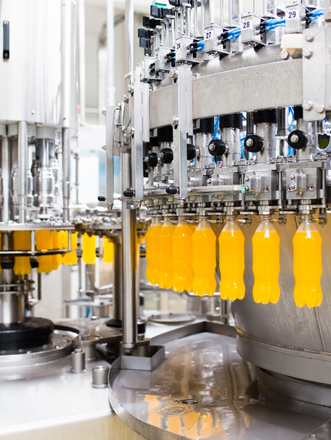

Carbon Dioxide (CO2) is a slightly toxic, odorless, colorless gas with a slightly pungent, acid taste. CO2 is commercially obtained as a by-product from a variety of sources including the manufacture of various chemicals (principally ammonia and hydrogen), thermal decomposition of carbonaceous materials, fermentation processes, Gases present in natural wells, geothermal sources, or produced from fuel combustion.
Beverage grade Carbon Dioxide is used in large quantities in the manufacture of carbonated Beverages, mostly soft drinks. All Food and Beverage grade CO2 undergoes a purification process; sometimes trace impurities make their way into the supply. The purity of Carbon Dioxide plays a key role in the quality & taste of the Beverage. It is thus essential to check the CO2 impurities before being used for Food & Beverages. The presence of Sulfur and certain Hydrocarbons in Carbon Dioxide gas can be corrosive, poisonous, and odorous.
Carbon Dioxide gas is used in Food and Beverages, Health Care, Rubber and Plastics Industry, Chemicals, Pharmaceuticals, Petroleum & Metals Industry.
At EFRAC, our environment division covers various analytical parameters for offering successful testing results to the clients. Our scientists of adequate expertise in separation techniques and have profound knowledge of analysing unknown chemical compounds. Specialists with industry based experience can analyze cases and deduce the root cause of reported problems.

Gas Division ………........ Carbon Dioxide (Co2)
WET CHEMISTRY:
• Purity of CO2
COLORIMETRIC:
• Identification of CO2 • Phosphine • Ammonia • Nitric Oxide • Nitrogen Dioxide
INSTRUMENT:
• NVIR • Total Hydrocarbon as Methane • Total NVR • NVOR • Water Vapour • Oxygen, Carbon monoxide • Total Non-Methane Hydrocarbon • Methane • Acetaldehyde • Aromatic Hydrocarbon as Benzene • Total Sulphur Content • Sulphur Dioxide • Vinyl Chloride • Benzene • Toluene • Ethylbenzene • o-xylene • m-xylene • p xylene • Ethylene Glycol • Ethane • Ethylene • Propane • Propylene • iso-butane • n-butane • Isopantane, n-pentane, Butane, Hexanes, Hydrogen sulphide, Carbonyl sulphide, Methyl Mercaptan, Ethyl Mercaptan, Dimethyl sulphide, Carbon disulphide, t-Butyl mercaptan, Isopropyl Mercaptan • n-propyl mercaptan • Methyl ethyl sulphide • 2-butyl Mercaptan • i-butyl Mercaptan • Diethyl sulphide • n-butyl Mercaptan • Dimethyl Disulphide • Dimethyl ether • Ethylene Oxide • Diethyl Ether • Propionaldehyde • Acetone • Methanol • t-Butanol • Ethanol • ISO Propanol • Ethyl Acetate • Methyl Ethyl Ketone • 2-Butanol • n-propanol • Isobutanol • n-Butanol • Isoamyl Alcohol • Iso amyl Acetate